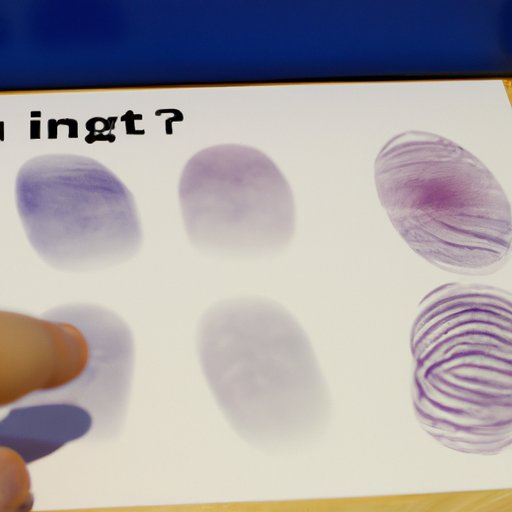Introduction
Fingerprints have long been a source of fascination for scientists and laypeople alike. From ancient Babylonian clay tablets to modern biometric security systems, fingerprints have been used as evidence of identity for thousands of years. But what exactly is a fingerprint, and how are they inherited? These questions can be answered through a science fair project that explores the science behind inherited fingerprints.
Exploring the Science Behind Inherited Fingerprints: A Science Fair Project
A fingerprint is an individual’s unique pattern of ridges, whorls, and loops on the surface of their fingertips. They are formed in the womb and remain unchanged throughout life, making them a reliable method of identification. But how are these patterns inherited? To answer this question, a science fair project can be created to explore the science behind inherited fingerprints.
First, it is important to understand what a fingerprint is. Fingerprints are formed by the friction ridges that form on the pads of the fingers and thumbs. These ridges contain sweat glands that secrete oils and proteins, which leave a distinctive pattern on surfaces when touched. This pattern is unique to each person and remains unchanged over time.
The next step is to look at how fingerprints are inherited. Studies suggest that fingerprints are determined by a combination of genetic and environmental factors. Research has identified certain genetic markers that are associated with specific fingerprint patterns. For example, one study found that people with a particular gene variant were more likely to have loop-shaped fingerprints than those without the variant.
Once the basics of fingerprint inheritance have been understood, experiments can be conducted to explore this topic further. Some possible experiments include comparing the fingerprints of family members to see if there are similarities, or creating a database of fingerprints from different generations to observe any changes over time.
Examine the Genetics of Fingerprints: An In-Depth Science Fair Project
For a more in-depth science fair project, students can investigate the genetics of fingerprints. The first step is to identify the genetic markers associated with specific fingerprint patterns. These markers can then be studied to determine how they influence the formation of fingerprints.
One way to do this is to create a database of fingerprints from people with known genetic markers. By comparing the fingerprints of those with the same marker, it is possible to determine whether the marker affects the pattern of the fingerprint.
In addition, experiments can be conducted to explore the relationship between genetics and fingerprint patterns. For example, researchers could create a database of fingerprints from family members to see if certain patterns are passed down through generations. Alternatively, they could compare the fingerprints of identical twins to see if their patterns are the same.

Understanding How Fingerprint Patterns are Passed Down Through Generations: A Science Fair Project
Another interesting topic for a science fair project is understanding how fingerprint patterns are passed down through generations. Studies have shown that fingerprints can change slightly over time due to environmental factors such as aging and exposure to chemicals. However, the basic pattern of a fingerprint remains the same, suggesting that there is a genetic component to its inheritance.
To investigate this further, experiments can be conducted to examine how fingerprint patterns change over generations. For example, researchers could create a database of fingerprints from family members spanning several generations to observe any changes. Additionally, they could compare the fingerprints of identical twins at different ages to see if the patterns remain the same.

Investigating the Genetic Link to Fingerprint Patterns: A Science Fair Project
Finally, a science fair project can be created to investigate the genetic link to fingerprint patterns. To do this, researchers can use DNA testing to identify genetic markers associated with specific fingerprint patterns. Once these markers are identified, they can be studied to determine how they influence the formation of fingerprints.
In addition, experiments can be conducted to explore the relationship between genetics and fingerprint patterns. For example, researchers could create a database of fingerprints from family members to see if certain patterns are passed down through generations. Alternatively, they could compare the fingerprints of identical twins to see if their patterns are the same.

Uncovering the Mysteries of Fingerprint Genetics: A Science Fair Project
Finally, a science fair project can be created to uncover the mysteries of fingerprint genetics. Despite decades of research, there are still many unanswered questions about the inheritance of fingerprints. To begin exploring these mysteries, researchers can conduct experiments to study the genetic markers associated with specific fingerprint patterns.
In addition, experiments can be conducted to examine how fingerprint patterns change over generations. For example, researchers could create a database of fingerprints from family members spanning several generations to observe any changes. Additionally, they could compare the fingerprints of identical twins at different ages to see if the patterns remain the same.
Conclusion
Fingerprints are an intriguing and fascinating subject, and they can provide insight into the mysteries of human genetics. Through a science fair project, students can explore the science behind inherited fingerprints and uncover the answers to some of the most intriguing questions surrounding this topic. By examining the genetics of fingerprints, investigating the genetic link to fingerprint patterns, and understanding how fingerprint patterns are passed down through generations, students can gain a deeper understanding of this fascinating topic.
(Note: Is this article not meeting your expectations? Do you have knowledge or insights to share? Unlock new opportunities and expand your reach by joining our authors team. Click Registration to join us and share your expertise with our readers.)
